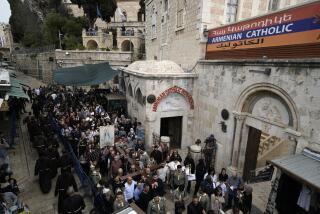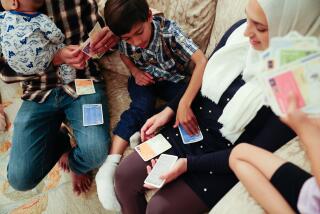Practice Evolved From Age of Persecution : Japan’s Hidden Christians Keep Faith That Few Understand
- Share via
IKITSUKI ISLAND, Japan — Passing to the next world from this windy island of farmers and fishermen in western Japan often requires not one funeral but two.
One is the Buddhist rite for the dead that is standard in Japan. The other is known only in a few isolated communities like this and will be remembered by the assembled family and friends of the deceased as the real funeral.
First an elderly man in ceremonial blue kimono bathes to purify himself. Then he prays before a wooden altar that includes a scroll painting of a Japanese-looking Mary and Jesus.
At the home of the deceased, a candle is lit, and the man chants 30 or 40 minutes of prayers, mixing Japanese and words that scholars can recognize as Latin.
Ikitsuki Island is a stronghold of kakure kurishitan , or Hidden Christians, believers in a remarkable, hybrid religion that evolved during anti-Christian persecutions in Japan in the 17th to 19th centuries.
It survives today, with many of the practices of stealth and deception that adherents needed in former days to stay alive.
“All that we have inherited in our faith has divine virtue and holiness,” said Hatsue Kita, a refuse-collection contractor who is oyaji-san (father) to a 37-household cell of Hidden Christians on the island. “We believe in it and respect it,” he said. “We feel no need to change.”
Experts estimate that only about 10,000 Hidden Christians remain here and in other corners of western Japan. Neither Catholic nor Protestant churches recognize them as Christians. But the people see themselves as living by the teachings of the Jesuit missionaries, who reached Japan in 1549.
Christianity flourished in the ensuing century, with as many as 300,000 Japanese being baptized. Foreign priests became confidants in court life, and there was talk of total conversion of Japan.
But in stages, the country’s rulers came to see Christianity as a threat. In 1597, 26 foreign and Japanese Christians were crucified on a hillside overlooking Nagasaki harbor. In 1614, the central government ordered all foreign missionaries expelled. In 1638, an estimated 37,000 Christians were slaughtered after a failed rebellion on Kyushu Island. Japan closed itself to the outside world, and Christianity was deemed destroyed.
Japan reopened more than two centuries later, and missionaries returned. In 1865, a foreign priest in Nagasaki was astonished when a group of Japanese approached him and declared, “We are one in the heart with you.”
The world learned that Christians had worshiped in secret for more than two centuries, like those in the catacombs of pagan Rome.
Over the years they had migrated to outer islands, where spies were less common. They joined Buddhist temples to avert suspicion.
As was required for everyone, they trampled on religious pictures once a year before officials’ gaze to prove they were not Christians. Afterward they atoned in private with acts of contrition.
At home some kept Christian altars and statuettes of a woman and child. To outsiders, it was the Buddhist goddess of mercy, Kannon; to Christians, it was Mary and Jesus. Their reverence came to focus on her, as has happened among Roman and Orthodox Catholics in many countries.
Organized into cells with hereditary leaders, they whispered calls to worship on village streets and gathered in private homes. Documents were potentially incriminating, so leaders passed down to sons, word for word by memory, the Roman Catholic liturgy as best they could.
In somewhat mangled Latin or Greek, many elements of the Catholic liturgy, such as the Ave Maria, Salve Regina and Pater Noster, survived. “Kyrie eleison, Christe eleison,” (Lord, have mercy upon us; Christ, have mercy upon us), words from the Catholic Mass, survived in spoken form on Ikitsuki as “Kiriya Rentsu, Kirisute Rentsu.”
Thousands of Hidden Christians rejoined the Catholic Church in the years after 1865. But many chose, and still choose, to remain separate. As ordinary Catholics, sect leaders would lose their powerful community status. And Hidden Christians pay no tithes.
But also keeping them out is the fact that they are not Christians in any ordinary sense. They do not believe in (or seem to know about) the idea of a single, all-powerful God, of salvation through Christ or a host of other basic principles of the religion.
Christianity as they know it is what any religion traditionally has been to many Japanese, a set of mysterious rites that need not be understood, only conducted.
Goal Is Harmony
The goal is to maintain harmony between the natural and supernatural worlds. “We must work hard not to offend heaven,” said Hiroshi Ohata, a former leader of Kita’s cell.
Ikitsuki’s people celebrate Flower Day in March. For years they had no idea why. Only recently they have discovered that it had evolved from Palm Sunday, the marking with palm leaves of Christ’s entry into Jerusalem.
At his home, Kita, the refuse-collection contractor, daily recites the prayers, many of which he cannot understand. He crosses himself. On special occasions, he offers sake and fruit to his wooden altar, which, as in the old days, is concealed by doors and located in a back room of his house. About once a month his cell gathers in his house for joint prayers.
With visitors, he fends off questions about abstract beliefs. He is more interested in showing the special ceremonies and conventions: how as leader he must drink from a tall tea cup, for instance, and wear a stiff belt with his ritual kimono.
Ancestor Worship
The faith is also grounded firmly in the ancestor worship that has long been prominent in Japanese religion. “Many of their forebears were martyrs,” says Kentaro Miyazaki, a professor at Junshin Women’s Junior College outside Nagasaki and a specialist in Japanese Christian history. “The people today worship those courageous acts of faith.”
Like most Japanese, the Hidden Christians see no problem in practicing several religions at once. Kita’s home also has a Buddhist shrine and one for the indigenous Japanese Shinto faith.
In the old days they were for show, Hidden Christians explain. But they say that over the years they came to believe in those gods too.
Traditional Christianity, meanwhile, has never recovered from the feudal persecutions. Despite decades of concerted efforts by foreign missionaries, less than 1% of today’s 120 million Japanese are baptized.
The Hidden Christians are not faring much better. “If people would remain on the island,” said Kunihiro Ogawa, chairman of Ikitsuki’s cultural association, “it would be easy to maintain the religion. But there’s no industry here. Young people have got to leave.”
More to Read
Sign up for Essential California
The most important California stories and recommendations in your inbox every morning.
You may occasionally receive promotional content from the Los Angeles Times.













